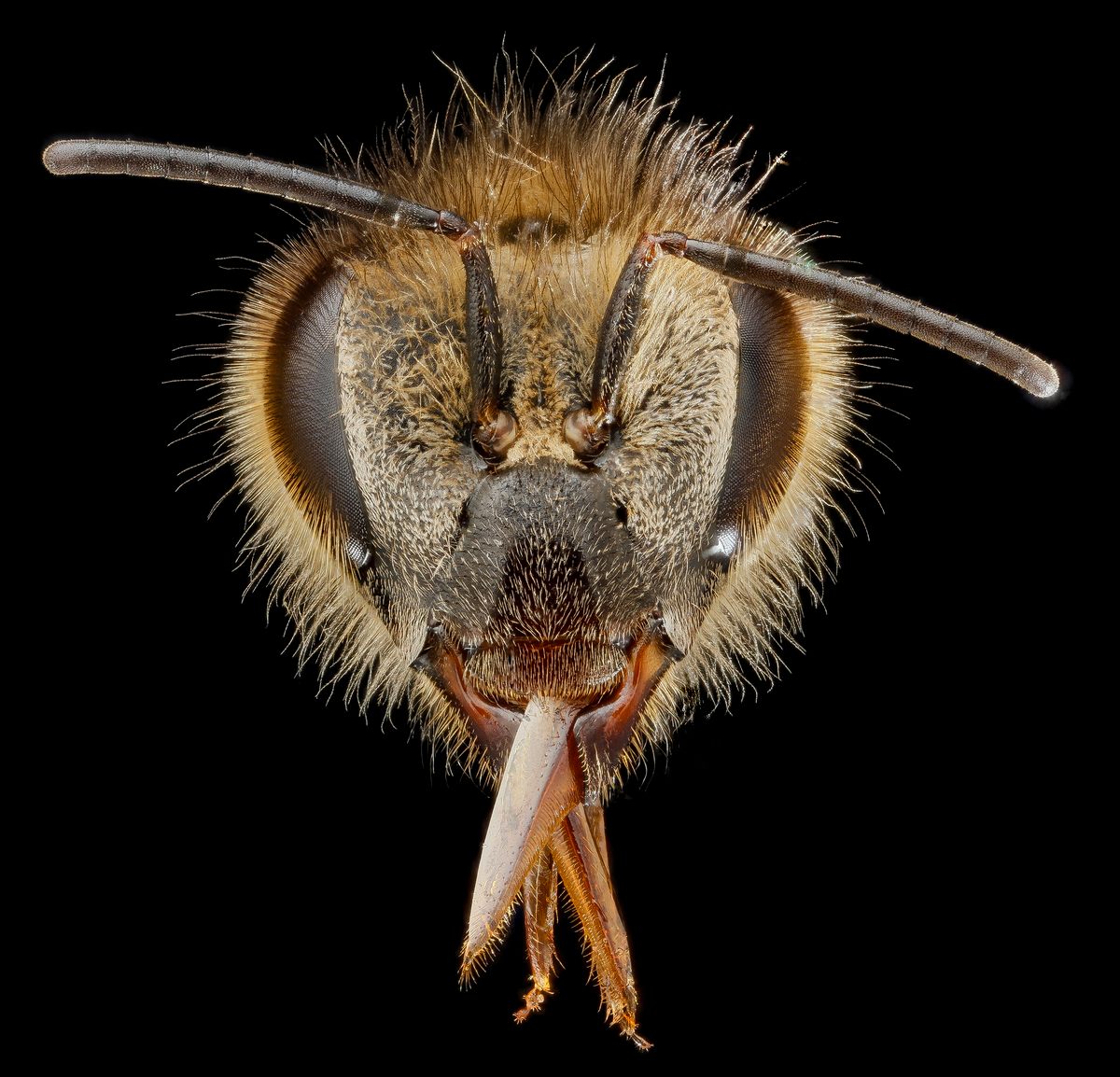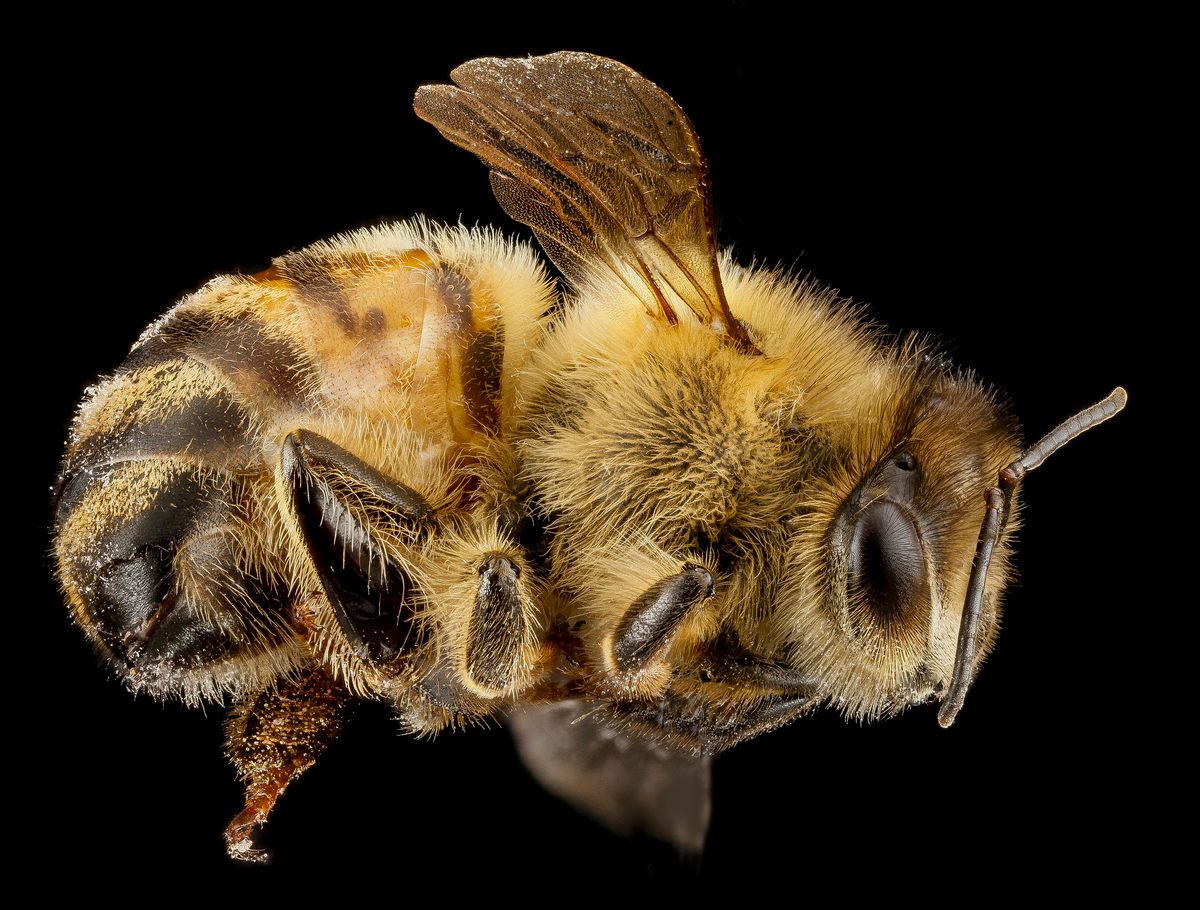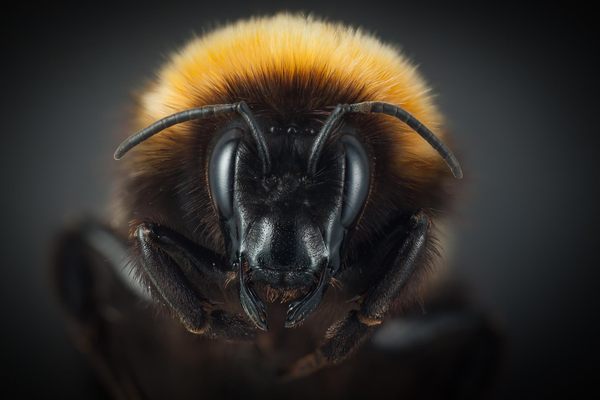What Is It Like to Be a Bee?
A philosophical and neurobiological look into the apian mind.
You’re a honeybee. Despite being around 700,000 times smaller than the average human, you’ve got more of almost everything. Instead of four articulated limbs, you have six, each with six segments. (Your bee’s knees, sadly, don’t exist.) You’re exceptionally hairy. A shock of bristly setae covers your body and face to help you keep warm, collect pollen, and even detect movement. Your straw-like tongue stretches far beyond the end of your jaw, but has no taste buds on it. Instead, you “taste” with other, specialized hairs, called sensillae, that you use to sense the chemicals that brush against particular parts of your body.
You’ve got five eyes. Two of them, called compound eyes and made up of 6,900 tiny lenses, take up about half your face. Each lens sends you a different “pixel,” which you use to see the world around you. The colors you see are different. Red looks like black to you and your three “primary” colors are blue, green, and ultraviolet. You detect motion insanely well, but outlines are fuzzy and images blocky, like a stained-glass window. (Your three other eyes detect only changes in light to tell you quickly if something dangerous is swooping your way.)
Now that you’re a honeybee you can do all kinds of things you couldn’t before. Your four wings move at 11,400 strokes per minute. You can sense chemicals in the air. You’re fluent in waggle dance, so you’re able to tell the other members of your colony where the nectar supplies are. But how much does any of this tell us about what it actually feels like to be a bee?

We all know what it’s like to be ourselves—to be conscious of the world around us, and be conscious of that consciousness. But what consciousness means more generally, for other people and other creatures, is a hot potato tossed between philosophers, biologists, psychologists, and anyone who’s ever wondered whether it feels the same to be a dog as it does to be an octopus. In general, we think that if you have some kind of unique, subjective experience of the world, you’re conscious to some extent. The problem is that in trying to envisage any consciousness besides our own, we run into the limits of the human imagination. In the case of honeybees, it’s hard to know if interesting behavior is reflective of an interesting experience of the world or masks a more simple stimulus-response existence. The lights are on, but is anyone home? To examine these questions means to take a ride on that hot potato—from philosopher to scientist and back again and again and again.
More and more, scientific research seems to suggest that bees do have a kind of consciousness, even as myths and misconceptions about their capacities persist. In a recent TED Talk, cognitive scientist Andrew B. Barron of Macquarie University in Sydney, Australia, described how he had had to be lovingly “talked down” from a “pearl-clutching” moment after someone asked him whether bees actually have brains. They do, of course.
Understanding what their consciousness might look or feel like is probably a fool’s errand. It’s really hard to imagine what it’s like to be almost anything or anyone other than what you are, says philosopher Colin Klein, also from Macquarie University, who has worked extensively alongside Barron. With people, it’s much easier. “You can talk to them, you can read fiction, there are a lot of things you can do—but it takes a certain amount of work to get into that space and in particular to realize what you experience, what you don’t experience, what your horizons look like,” he says. But the more different the experience of the organism you’re trying to imagine is, the harder it becomes. “You can start to think at least in what senses the experience of something like a bee might be different from ours”—how they structure the world around them, say, or whether they experience “space” the way we do.
The philosopher Thomas Nagel’s famous 1974 essay, “What Is It Like to Be a Bat?” suggests that being “like” something else is possible only if the target is conscious of the world around it. “The fact that an organism has conscious experience at all means, basically, that there is something it is like to be that organism,” he writes. Or, “fundamentally an organism has conscious mental states if and only if there is something that it is to be that organism—something it is like for the organism.” On top of that mindscrabble, our ability to imagine ourselves as another being is limited by the world that we know—as people. We might be able to imagine having webbed arms and hands, like a bat, or five eyes, like a bee, but the specific senses and abilities these animals possess are frankly inconceivable. “I want to know what it is like for a bat to be a bat. Yet if I try to imagine this, I am restricted to the resources of my own mind, and those resources are inadequate to the task,” he adds. Moreover, “I cannot perform it either by imagining additions to my present experience, or by imagining segments gradually subtracted from it.”
Despite these difficulties, what we want to know, Klein and Barron wrote in an op-ed in The Conversation in 2016, is whether bees and other insects “can feel and sense the environment from a first-person perspective.”

It seems likely that there are lots of different kinds of consciousness, of varying levels of complexity. As human beings, not only are we aware of ourselves and the world around us, we’re also aware of that awareness. A step down in complexity might lack that awareness of self-awareness. And a step down from that might be limited to a distinctive experience of the external world only.
Such a simple ladder may not be the best way to organize this kind of complexity, says David Chalmers, a leather jacket-wearing Australian philosopher at New York University best known for his work in philosophy of mind—a branch of philosophy that asks these kinds of questions. “But there are probably different ways of arranging states of mind, or consciousness, in a hierarchy,” he says. What’s harder to distinguish is the precise point where consciousness ends, and what the light switch, “on-off,” moment might be, further down the evolutionary chain. “It’s awfully hard to see what a borderline case of being conscious would be,” he says, even while it’s not that hard to know what a borderline case of being alive might look like, as in a virus. “It would sort of feel like something,” he says, trailing off in thought, “but not.”
So far as bee consciousness goes, however, he thinks there are likely to be some factors in consciousness that we share, like vision, and some that we don’t at all, “whether it’s sensory systems that humans have that bees don’t have, or whether it’s things more like concepts, like language, that give us a kind of consciousness that bees don’t have.”
Klein is more specific. “We think that bees have experiences that feel like something to the bee,” he says. “We don’t think the bees are aware of having experiences that feel like something to them. The bee is not going round saying to itself, ‘Gee, it’s a lovely day, look at that flower.’ It doesn’t have any of these more sophisticated, reflexive kinds of consciousness.”

Still, despite having a brain that is a fraction of the size of even the tiniest mammal’s, bees seem capable of some incredibly complex behaviors and mental gymnastics. Studies over the last few decades have revealed them to do everything from having a concept of zero to experiencing emotion, from tool use to social learning. If you give them cocaine, they dance more vigorously and tend to overestimate how much pollen they’ve foraged. If they watch a plastic bee scoring goals with a soccer ball, they can follow suit for a sugar water reward. Wouldn’t these complex behaviors be enough to assume some kind of consciousness? Not necessarily, says Barron. “Honeybees are unusual among the insects in that they have a whole list of clever things that they are able to do,” he says. “And some people would say that that means that they are more likely to be conscious. I disagree with that.”
Think of all the other things able to perform complicated tasks that we’re pretty sure aren’t conscious. Robots do everything from juggle to play the piano, but, as far as we know, are “dark” inside. Like bees, Roomba vacuum cleaners make decisions, navigate around the world, and adapt—but there’s probably nothing it’s “like” to be one of them. And plants have been shown to have a kind of memory: Over time, for example, they can learn that being repeatedly dropped isn’t anything to freak out about. But few suggest they possess consciousness.
“I think this is one of the problems with the behavioral approach, is that it encourages this looking for very clever things,” says Klein. “Whereas if consciousness is a widespread phenomenon, you should expect that it might be in a lot of different types of things that don’t necessarily do the things that we take to be markers of consciousness.”
If behavior can’t enough tell us about the inner life of a bee, perhaps the structure of their sesame seed–sized brains can. In a human brain, key studies suggest consciousness lies in the midbrain, an evolutionarily much older section. In a study published last year, Barron and Klein investigated the structure of the bee brain, which seems to be made up of similar bits to our own, with a region responsible for similar tasks. “It’s smaller, it’s organized differently, it’s different-shaped, but if you look at the kind of computations it does, it’s doing the same sort of things as the midbrain,” Klein says. “So if you think in humans the midbrain is responsible for being conscious, and you think this is doing the same kind of thing, then you ought to think insects are conscious as well.”

This biological approach opens up consciousness to a variety of other organisms that don’t do the clever things that bees do, like beetles or potato bugs. They might be less obviously interesting, but that doesn’t make them less likely to be conscious. The technology that allows us to examine insect brains on a neuron-by-neuron level is very new, Barron says. “If they really are instinctive, then we’re learning something about what the insect brain is capable of. If they’re not, then we’re learning something more profound.”
The technology also allows us to map the brains of organisms that we think probably aren’t conscious, and assess what they lack. Caenorhabditis elegans is a roundworm commonly used in scientific research. In recent years, scientists have developed a connectome—a sort of complex brain map—for this tiny soil-dweller, which measures barely a millimeter in length. “They have 302 neurons,” says Klein, compared to a bee’s 960,000 and a human’s 86 billion. “Those [worms], we think, are actually very much like robots, like complicated robots.” If exposed to a particular stimulus, they respond in a particular, predictable way. “Unless there’s some kind of danger, and then it does that, unless it’s hungry, and then it does this—so you can really map out what it’s going to do.” In bees, he says, there seems to be a kind of qualitative shift, in which the brain is somehow more than its connections.

All of this neurobiology is beginning to paint a picture—that it feels like nothing to be a C. elegans, or a robot, or a plant, but it probably feels like something to be a bee. If that’s the case, it is still not known where, between the roundworm and the honeybee, that awareness switches on, if it does. While neurobiology is a very important part of the story, says Chalmers, “it may not settle the issue of consciousness. You very frequently find a situation where two people might agree on the neurobiology of a given case, but disagree on what that implies about consciousness.” He gives the example of fish, and the ongoing discourse about whether their neurobiology suggests that they do or do not feel pain. “Knowing the neurobiological facts doesn’t necessarily settle the question.”
We can try to imagine what it’s like to have six hairy legs, or see in pixels, or crave nectar. We can even try to imagine what it’s like to be part of a hive, a superorganism with motivations of its own. But what it’s actually like to be a bee—its subjective experience of the world—is going to remain elusive. But we’re starting to figure out that it’s probably like something. And that’s not nothing.














Follow us on Twitter to get the latest on the world's hidden wonders.
Like us on Facebook to get the latest on the world's hidden wonders.
Follow us on Twitter Like us on Facebook